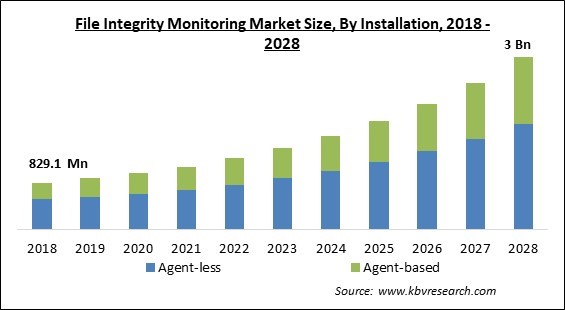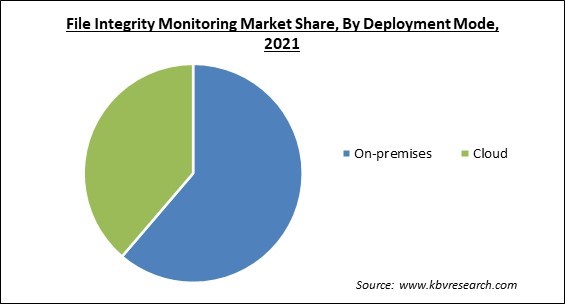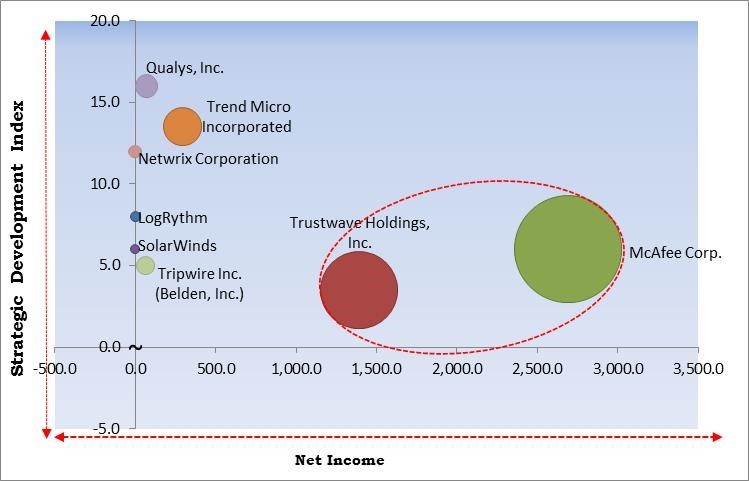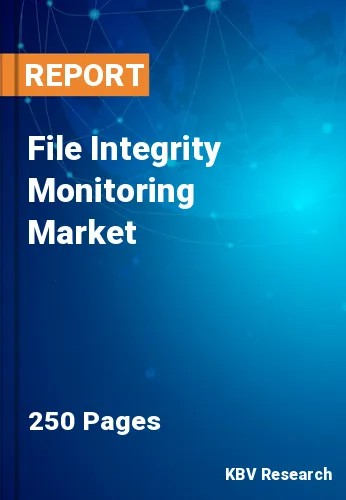The Global File Integrity Monitoring Market size is expected to reach $3 billion by 2028, rising at a market growth of 15.9% CAGR during the forecast period.
File Integrity Monitoring (FIM) is an internal control procedure that can test the integrity of application software files and the operating system. Using an authentication method, the file integrity monitoring system verifies the integrity of these sectors by identifying the current file state and comparing it to a known good baseline.

Employing a file integrity monitoring system has various advantages, such as the system's capacity to track human mistakes, determine the origin of the attack, and manage and govern the data. File integrity monitoring is one of the most important IT security processes for authenticating the integrity of end-user, application software, and operating system files in order to safeguard the IT infrastructure from all types of threats.
In addition, this technology features an internal procedure or control to detect and monitor file changes by evaluating the application software as well as the operating system's integrity (OS). The method for validating file integrity monitoring comprises comparing a cryptographic checksum with a calculated checksum. In addition, it aids in showing the information and reviewing the file to determine when and how it was modified.
File Integrity Monitoring is essential for safeguarding and sustaining infrastructures, such as websites and servers. This solution verifies the authenticity of a specific environment by determining whether the website's files have undergone unanticipated changes. File Integrity Monitoring can be used to identify file modifications in web servers, operating systems, and online applications, like WordPress.
Even monitoring file-based software solutions, such as databases or configuration files, is possible. Organizations that employ a file integrity monitoring system are more likely to notice security breaches early on, giving them a greater chance of remaining online and avoiding serious harm. File Integrity Monitoring is largely regarded as a security solution for this reason.
The pandemic that was caused by COVID-19 has had a favorable impact on the file integrity monitoring market. This is because the significant number of cyber threats has increased in a variety of countries all over the world during the pandemic. The practice of file integrity monitoring has been adopted by nations all around the world in order to examine and safeguard their data. Moreover, various governments as well as national authorities provided critical infrastructure providers with guidance on how to protect themselves from cyber threats and cyberattacks. This was due to the fact that the majority of businesses were working remotely during the COVID-19 pandemic. Thus, all these factors played a major role in boosting the growth of the file integrity market during the COVID-19 pandemic.
A data breach occurs when information is stolen or withdrawn from a system without the owner's knowledge or authorization. Large companies and organizations are typically the targets of data breaches. The stolen information may include consumer data, credit card details, corporate secrets, and information related to national security. Despite increased protection, government and healthcare organizations are the primary targets of cyberattacks because of the valuable personal data they collect, which may be sold.
The Internet of Things (IoT) is a technology that allows physical objects to connect to the Internet and communicate via a predetermined network. It is anticipated that the number of Internet-connected devices would skyrocket in the coming years. This novel framework has the potential to radically alter how humans connect, interact, and comprehend the universe by enabling creative techniques to interfere with practices at the single-molecular level and therefore by extending human control as well as consciousness with AI algorithms cooperatively sensing and responding to environments never before examined by any other paradigm.
One of the major factors that are hampering the growth of the file integrity monitoring market is the complexities involved with the usage of the cloud. Due to the digitization of paper documents as well as the long-term storage of information in order to comply with legal requirements, the amount of data that must be stored has expanded substantially. The expansion in data storage has become a major challenge for organizations, governments, small businesses, and people. Users may invest in external hard drives or new gadgets, but an increasing trend is to make use of cloud storage's benefits.

Based on Installation, the File Integrity Monitoring Market is bifurcated into Agent-Based and Agent-less. In 2021, the agent-less segment acquired the largest revenue share of the file integrity monitoring market. The growth of segment is expanding at a very rapid pace because of its cost-effectiveness and lower user switching costs. The proxy agent is an agent installed on a management server or device that performs agentless monitoring.
On the basis of Deployment Mode, the File Integrity Monitoring Market is divided into Cloud and On-Premise. In 2021, the cloud-based segment recorded a substantial revenue share of the file integrity monitoring market. It offers numerous advantages to users, including simple installation and no upkeep. It eliminates the need to manage distinct agents for various security solutions, such as detecting policy as well as compliance-related changes across vast IT environments and for compliance with stringent requirements.
By Organization Size, the File Integrity Monitoring Market is categorized into SMEs and Large Enterprises. In 2021, the large enterprise segment witnessed the highest revenue share of the file integrity monitoring market. Government restrictions that are favorable to major businesses compel them to safeguard their data. The majority of countries have begun putting new laws on all organizations' electronic communications as well as stored data.
Based on Vertical, the File Integrity Monitoring Market is segregated into BFSI, Government, Healthcare, Education, IT & Telecom, and Others. In 2021, the government segment registered a substantial revenue share of the file integrity monitoring market. Hacktivists and cybercriminals constantly pose a threat to government infrastructure and networks around the world. As the world is becoming more digital and connected, a significant amount of government data is being shifted onto the internet.
| Report Attribute | Details |
|---|---|
| Market size value in 2021 | USD 1.1 Billion |
| Market size forecast in 2028 | USD 3 Billion |
| Base Year | 2021 |
| Historical Period | 2018 to 2020 |
| Forecast Period | 2022 to 2028 |
| Revenue Growth Rate | CAGR of 15.9% from 2022 to 2028 |
| Number of Pages | 250 |
| Number of Tables | 444 |
| Report coverage | Market Trends, Revenue Estimation and Forecast, Segmentation Analysis, Regional and Country Breakdown, Competitive Landscape, Companies Strategic Developments, Company Profiling |
| Segments covered | Installation, Deployment Mode, Organization Size, Vertical, Region |
| Country scope | US, Canada, Mexico, Germany, UK, France, Russia, Spain, Italy, China, Japan, India, South Korea, Singapore, Malaysia, Brazil, Argentina, UAE, Saudi Arabia, South Africa, Nigeria |
| Growth Drivers |
|
| Restraints |
|
Region-wise, the File Integrity Monitoring Market is analyzed across North America, Europe, Asia-Pacific, and LAMEA. In 2021, North America accounted for the largest revenue share of the file integrity monitoring market. The growing use of the Internet, the development of software and IT infrastructure in businesses, and the escalation of cyber-attacks are driving the regional market. Moreover, countries throughout the region are early adopters of new technologies, which is offering a number of new growth prospects to regional market players.
Free Valuable Insights: Global File Integrity Monitoring Market size to reach USD 3 Billion by 2028

The major strategies followed by the market participants are Partnerships, Collaborations and Agreements. Based on the Analysis presented in the Cardinal matrix; McAfee Corp. and Trustwave Holdings, Inc. are the forerunners in the File Integrity Monitoring Market. Companies such as Trend Micro Incorporated, Qualys, Inc., Tripwire, Inc. are some of the key innovators in File Integrity Monitoring Market.
The market research report covers the analysis of key stake holders of the market. Key companies profiled in the report include SolarWinds Corporation, Cimcor, Inc., LogRhythm, Inc., Trustwave Holdings, Inc. (Singapore Telecommunications Ltd.) (Temasek Holdings), ManageEngine (Zoho Corporation), Trend Micro, Inc., Qualys, Inc., Netwrix Corporation, McAfee Corp., and Tripwire Inc. (Belden, Inc.)
By Installation
By Deployment Mode
By Organization Size
By Vertical
By Geography
The global File Integrity Monitoring Market size is expected to reach $3 billion by 2028.
Rising Frequency Of Cyber-Attacks And Data Breaches are driving the market in coming years, however, An Increasing Number Of Complexities As Well As Security Risks In The Cloud-Based FIM Systems restraints the growth of the market.
SolarWinds Corporation, Cimcor, Inc., LogRhythm, Inc., Trustwave Holdings, Inc. (Singapore Telecommunications Ltd.) (Temasek Holdings), ManageEngine (Zoho Corporation), Trend Micro, Inc., Qualys, Inc., Netwrix Corporation, McAfee Corp., and Tripwire Inc. (Belden, Inc.)
The On-premises segment is leading the Global File Integrity Monitoring Market by Deployment Mode in 2021 thereby, achieving a market value of $1.7 billion by 2028.
The BFSI segment acquired maximum revenue share in the Global File Integrity Monitoring Market by Vertical in 2021 thereby, achieving a market value of $793.2 million by 2028.
The North America market dominated the Global File Integrity Monitoring Market by Region in 2021, and would continue to be a dominant market till 2028; thereby, achieving a market value of $1 billion by 2028.
Our team of dedicated experts can provide you with attractive expansion opportunities for your business.

